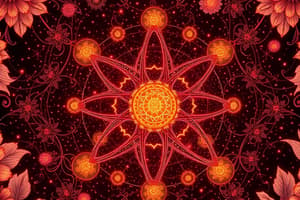Podcast
Questions and Answers
What is the main function of protons in an atom?
What is the main function of protons in an atom?
- To provide most of the mass of the atom
- To provide a negative charge to balance electrons
- To provide a positive charge to balance electrons (correct)
- To hold electrons together in the nucleus
Which part of an atom contributes most to its mass?
Which part of an atom contributes most to its mass?
- Electron cloud
- Nucleus
- Protons (correct)
- Neutrons
Where can electrons be found in relation to the nucleus of an atom?
Where can electrons be found in relation to the nucleus of an atom?
- Attached to the protons within the nucleus
- In a region around the nucleus called the electron cloud (correct)
- Within the neutron shell
- Inside the nucleus
What is the role of neutrons in the atomic nucleus?
What is the role of neutrons in the atomic nucleus?
Which statement best describes the electron cloud in an atom?
Which statement best describes the electron cloud in an atom?
How do atoms bond with each other to form molecules?
How do atoms bond with each other to form molecules?
Flashcards are hidden until you start studying
Study Notes
An atom is the smallest particle of an element which can enter into chemical combination with other elements. It consists of three main parts — the atomic nucleus, the orbiting electrons, and a region where there's a probability distribution function called the electron cloud. Let's delve deeper into these components.
The core part of the atom is its atomic nucleus, containing most of the mass of the entire atom. In the center of this nucleus are positively charged particles known as protons, which carry one unit of positive electric charge each. These protons attract negative particles from outside the nucleus known as electrons, which balance out their charges, keeping the atom stable. Electron clouds consist of regions around the nucleus where it is probable to find electrons at any given time; they have zero volume but occupy all space. Electrons orbit the nucleus like planets orbit the sun. Neutrons contribute to the size and stability of the nucleus by holding protons together and counterbalancing some of the repulsion between them due to their neutral charge.
Atoms have properties such as boiling points, melting points, density, and reactivity. They also have the ability to bond with each other through covalent bonds, ionic bonds or metallic bonds depending on how many valence electrons the atom has. Atoms combine to form molecules and matter because of the forces of attraction between atoms. Without the attractive force between atoms, everything would fly apart. Thus, understanding the basic structure of atoms is crucial to understanding matter itself.
Studying That Suits You
Use AI to generate personalized quizzes and flashcards to suit your learning preferences.




